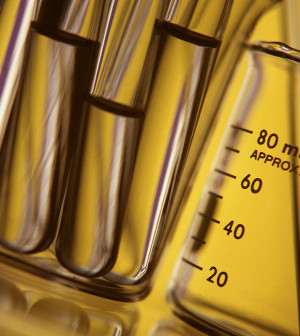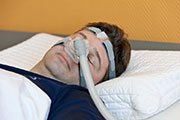- Skip Storing This Everyday Product in the Fridge Door
- Green Tea + B3 Pairing May Boost Brain Health
- Navigating Your Midlife Crisis: Embracing New Possibilities
- City Raccoons Showing Signs of Domestication
- Mapping the Exposome: Science Broadens Focus to Environmental Disease Triggers
- One Week Less on Social Media Linked to Better Mental Health
- Your Brain Changes in Stages as You Age, Study Finds
- Some Suicide Victims Show No Typical Warning Signs, Study Finds
- ByHeart Formula Faces Lawsuits After Babies Sickened With Botulism
- Switch to Vegan Diet Could Cut Your Greenhouse Gas Emissions in Half
Portable Monitors OK for Spotting Sleep Apnea: New Guidelines


For most people, portable sleep monitors are an adequate substitute for an overnight stay in a sleep laboratory for the diagnosis of obstructive sleep apnea, according to new guidelines issued by the American College of Physicians.
Obstructive sleep apnea — a condition that causes people to stop breathing temporarily many times a night during sleep — can be diagnosed in two basic ways. One is to send them to a sleep laboratory where they can be monitored overnight or, if a sleep lab isn’t available, give them a portable sleep monitor to take home.
The portable monitors have become more widely used in the last few years, according to the co-author of the guidelines, Dr. Jon-Erik Holty, a staff critical care pulmonologist and sleep physician with VA Palo Alto Health Care System. Insurance companies tend to prefer the low cost of the monitors rather than the higher expense of sleep labs with employees who monitor patients overnight.
“For the average person, they’re just as accurate as an in-lab study,” said Holty.
However, the guidelines’ authors cautioned that patients with congestive heart failure, chronic lung disease and neurological disorders should be checked in a sleep laboratory and not use a portable monitor.
The physician association is offering new guidelines about the diagnosis of sleep apnea as part of a follow-up to previous recommendations from the Agency for Healthcare Research and Quality, Holty said.
It’s estimated that about 9 percent of Americans have moderate to severe sleep apnea, according to Holty. The condition is more common in older people, he said.
People with the condition often have trouble staying in deep sleep because their throats close, blocking their airways. This requires them to subconsciously wake up to breathe again.
Sleep apnea does more than rob people of sound sleep and make them sleepy during the day. It’s also been linked to higher risk of heart attack, stroke, diabetes and thinking problems, although researchers haven’t proved that sleep apnea actually causes those things.
An estimated 90 percent of people with sleep apnea have not been diagnosed with the condition, Holty said.
The new guidelines, which appear in the Aug. 5 issue of Annals of Internal Medicine, are based on research findings from the last several decades.
The guidelines recommend that patients undergo a “sleep study,” either in a sleep lab or with a portable monitor, if they are sleepy during the day for an unexplained reason. The guidelines call this a “weak recommendation” based on “low-equality evidence.”
Holty said the portable monitors have become more common because they’re cheap to use — around $200 to $250. Insurers often refuse to pay for sleep studies in laboratories that can cost about $1,100, he said.
Using a portable monitor instead of a sleep laboratory means “you’re not paying someone to be up at night monitoring you, you’re not having to pay for the rent and the electricity,” Holty said. The portable monitors also offer an alternative to patients who don’t live near a sleep lab, he added.
Dr. Michael Thorpy, director of the Sleep-Wake Disorders Center at Montefiore Medical Center in New York City, pointed out that the portable home monitors don’t provide useful data in about 20 percent of patients. The portable monitors also can be unreliable at diagnosing sleep apnea in patients with mild forms of the condition, he added.
Insurers who insist on the machines “need to read these guidelines to understand that there are limitations,” he said.
As for treatment, patients are often prescribed masks that keep their airways open through pressurized air that enters their nostrils. But many patients can’t tolerate the masks and refuse to use them unless their sleep worsens.
In some cases, patients can improve sleep apnea through other treatments and by losing weight. Obesity is a risk factor for the condition.
Successfully treating sleep apnea can make a big difference to patients, Thorpy said. “They see improvement and not just in terms of their overall health benefits. They come in and say they’re so grateful because we’ve dramatically changed their lives.”
More information
Learn more about sleep apnea from the National Sleep Foundation.
Source: HealthDay
Copyright © 2025 HealthDay. All rights reserved.










